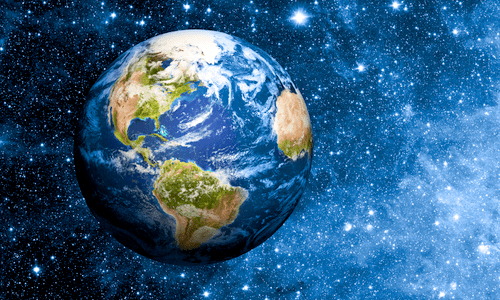NCERT Solutions for Class 6 Geography - Major Domains of the Earth
Q1. Answer the following questions briefly.
(a) What are the four major domains of the earth?
Ans: The four major domains of the earth are the lithosphere, hydrosphere, atmosphere and biosphere.
(b) Name the major continents of the earth?
Ans: The seven major continents of the Earth are Asia, Europe, Africa, North America, South America, Australia and Antarctica.
(c) Name the two continents that lie entirely in the Southern Hemisphere.
Ans: The two continents that lie entirely in the Southern Hemisphere are Australia and Antarctica.
(d) Name the different layers of the atmosphere.
Ans: The different layers of the atmosphere are the troposphere, stratosphere, mesosphere, thermosphere and exosphere.
(e) Why is the earth called the ‘blue planet’?
Ans: The earth is called the ‘blue planet’ because more than 71 percent of the earth is covered with water.
 Earth: Blue Planet
Earth: Blue Planet
(f) Why is the Northern Hemisphere called the Land Hemisphere?
Ans: The Northern Hemisphere called the Land Hemisphere because the greater part of Earth’s landmass lies in the Northern Hemisphere.
(g) Why is the Biosphere important for living organisms?
Ans: The biosphere is the narrow zone of contact between the land, water and air. It is in this zone that life, that is unique to this planet, exists. All the living organisms including humans are linked to each other and to the biosphere for survival.
Q2. Tick the correct answers.
(a) The mountain range that separates Europe from Asia is
(i) the Andes
(ii) the Himalayas
(iii) the Urals
Ans: (iii) the Urals
The Ural Mountains run north to south and form a natural boundary between the continents of Europe and Asia.
(b) The continent of North America is linked to South America by
(i) an Isthmus
(ii) a Strait
(iii) a Canal
Ans: (i) an Isthmus
This narrow strip of land, known as the Isthmus of Panama, connects the two continents.
(c) The major constituent of the atmosphere by percent is
(i) Nitrogen
(ii) Oxygen
(iii) Carbon dioxide
Ans: (i) Nitrogen
Nitrogen makes up about 78% of Earth's atmosphere, followed by oxygen at around 21%.
(d) The domain of the earth consisting of solid rocks is
(i) the Atmosphere
(ii) the Hydrosphere
(iii) the Lithosphere
Ans: (iii) the Lithosphere
The lithosphere includes the Earth's crust and the upper part of the mantle, which are composed of solid rock.
(e) Which is the largest continent?
(i) Africa
(ii) Asia
(iii) Australia
Ans: (ii) Asia
Asia is the largest continent in terms of both land area and population.
Q3. Fill in the blanks.
(a) The deepest point on the earth is __________ in the Pacific Ocean.
Ans: Mariana Trench
 The Depth of Mariana Trench is more than the height of Mt. Everest
The Depth of Mariana Trench is more than the height of Mt. Everest
(b) The _______________ Ocean is named after a country.
Ans: Indian
(c) The ___________ is a narrow contact zone of land, water and air that supports life.
Ans: Biosphere
(d) The continents of Europe and Asia together are known as ________________.
Ans: Eurasia
(e) The highest mountain peak on the earth is ______________.
Ans: Mount Everest
|
297 videos|1066 docs|204 tests
|
FAQs on NCERT Solutions for Class 6 Geography - Major Domains of the Earth
| 1. What are the major domains of the Earth? |  |
| 2. How does the Lithosphere affect human activities? |  |
| 3. What is the importance of the Hydrosphere for life on Earth? |  |
| 4. How does the Atmosphere protect life on Earth? |  |
| 5. What role does the Biosphere play in the Earth's systems? |  |

















